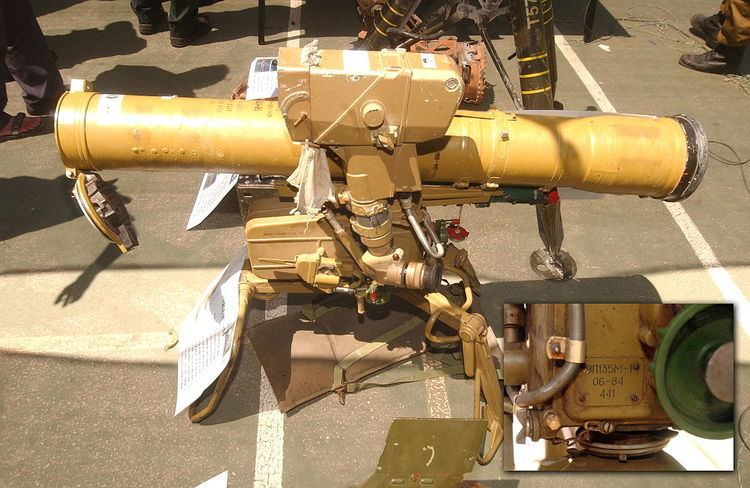Type Anti-tank missile In service 1974–present Designed 1970 | Used by See operators | |
 | ||
Manufacturer Tula Machinery Design Bureau (Tula KBP) – Tulsky Oruzheiny Zavod | ||
The 9M113 Konkurs (Russian: 9М113 «Конкурс»; cognate of French: Concours; English: "Contest") is a SACLOS wire-guided anti-tank missile of the Soviet Union. "9M113" is the GRAU designation of the missile. Its NATO reporting name is AT-5 Spandrel.
Contents
Development
The 9M113 Konkurs was developed by the Tula Machinery Design Bureau (Tula KBP). Development began with the aim of producing the next generation of SACLOS anti-tank missiles, for use in both the man-portable role and the tank destroyer role. The 9M113 Konkurs was developed alongside the 9M111; the missiles use similar technology, differing only in size. The warhead penetration is 600 mm vs rolled homogeneous armour (RHA).
The missile entered service in 1974. Iran began producing a copy, the Tosan (not to be confused with the Toophan), sometime around 2000.
Description
The missile is designed to be fired from vehicles, although it can also be fired from the later models of 9M111 launchers. It is an integral part of the BMP-2, BMD-2 and BRDM-2 vehicles. The missile is stored and carried in a fiberglass container/launch tube.
The system uses a gas generator to push the missile out of the launch tube. The gas also exits from the rear of the launch tube in a similar manner to a recoilless rifle. The missile leaves the launch tube at 80 meters per second, and is quickly accelerated to 200 meters per second by its solid fuel motor. This initial high speed reduces the missile's deadzone, since it can be launched directly at the target, rather than in an upward arc. In flight, the missile spins at between five and seven revolutions per second.
The launcher tracks the position of an incandescent infrared bulb on the back of the missile relative to the target and transmits appropriate commands to the missile via a thin wire that trails behind the missile. The system has an alarm that activates when it detects jamming from a system like Shtora. The operator can then take manual control, reducing the missile to MCLOS. The SACLOS guidance system has many benefits over MCLOS. The system's accuracy is quoted in some sources as 90%, though its performance is probably comparable to the BGM-71 TOW or later SACLOS versions of the 9K11 Malyutka.
